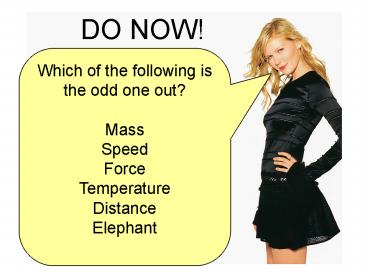Which of the following is the odd one out? - PowerPoint PPT Presentation
1 / 42
Title:
Which of the following is the odd one out?
Description:
DO NOW! Which of the following is the odd one out? Mass Speed Force Temperature Distance Elephant Resolving vectors into components Resolving vectors into components ... – PowerPoint PPT presentation
Number of Views:87
Avg rating:3.0/5.0
Title: Which of the following is the odd one out?
1
DO NOW!
Which of the following is the odd one
out? Mass Speed Force Temperature Distance Elepha
nt
2
DO NOW!
Which of the following is the odd one
out? Mass Speed Force Temperature Distance Elepha
nt
3
Scalars and vectors
4
Scalars
- Scalar quantities have a magnitude (size) only.
- For example
- Temperature, mass, distance, speed, energy.
5
Vectors
- Vector quantities have a magnitude (size) and
direction. - For example
- Force, acceleration, displacement, velocity,
momentum.
6
Scalars and Vectors
No direction
vectors
scalars
Magnitude (size)
Magnitude and direction
temperature
mass
velocity
force
acceleration
speed
7
Representing vectors
- Vectors can be represented by arrows. The length
of the arrow indicates the magnitude, and the
direction the direction!
8
Representing velocity
- Velocity can also be represented by an arrow.
The size of the arrow indicates the magnitude of
the velocity, and direction the direction! - When discussing velocity or answering a
question, you must always mention the direction
of the velocity (otherwise you are just giving
the speed).
9
Adding vectors
- When adding vectors (such as force or velocity)
, it is important to remember they are vectors
and their direction needs to be taken into
account. - The result of adding two vectors is called the
resultant.
10
Adding vectors
- For example
Resultant force
2 m/s
6 m/s
4 m/s
4 N
5.7 N
4 N
Resultant force
11
How did we do that?
12
How did we do that?
4 N
4 N
4 N
4 N
5.7 N
13
Scale drawing
- You can either do a scale drawing
?
1 cm 1N
? 45
14
Or by using pythagorous and trigonometry
Length of hypotenuse v42 42 v32 5.7 N Tan
? 4/4 1, ? 45
15
Subtracting vectors
- For example
Resultant velocity
10 m/s
6 m/s
4 m/s
4 N
5.7 N
4 N
Resultant force
16
Subtracting vectors
- For example
5.7 N
4 N
4 N
17
An interesting example
- Think of a dog (dead) orbiting the earth with
constant speed (in a circle).
18
An interesting example
- At this point, what is its velocity?
velocity?
19
An interesting example
velocity
20
An interesting example
What is its velocity here?
velocity?
21
An interesting example
As you can see the velocity has changed as it is
now going in another direction.
velocity
22
An interesting example
In uniform circular motion, we have constant
speed but changing velocity.
Of course a changing velocity means it must be
accelerating! Well come back to this next year!
velocity
23
Resolving vectors into components
24
Resolving vectors into components
- It is sometime useful to split vectors into
perpendicular components
25
Resolving vectors into components
26
A cable car question
27
Tension in the cables?
?
10
?
10 000 N
28
Vertically 10 000 2 X ? X sin10
?
10
?
? X sin10
? X sin10
10 000 N
29
Vertically 10 000/2xsin10 ?
?
10
?
? X sin10
? X sin10
10 000 N
30
? 28 800 N
?
10
?
? X sin10
? X sin10
10 000 N
31
What happens as the angle deceases?
? 10 000/2xsin?
?
?
?
10 000 N
32
Error bars
- X 0.6 0.1
- Y 0.5 0.1
33
Gradients
34
Minimum gradient
35
Maximum gradient
36
y mx c
37
y mx c
- Ek ½mv2
38
y mx c
- Ek ½mv2
Ek (J)
V2 (m2.s-2)
39
Lets try some questions!
Page 13 Questions 1 to 6
Resultant of forces (addition of vectors)
40
Sorry, I nearly forgot!
41
(No Transcript)
42
Resultant force































